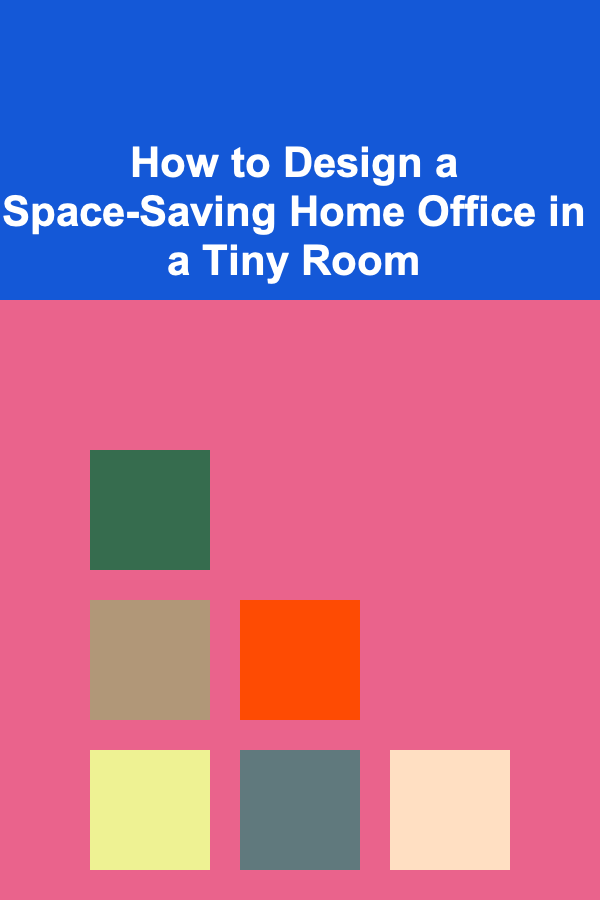
How to Design a Space-Saving Home Office in a Tiny Room
ebook include PDF & Audio bundle (Micro Guide)
$12.99$5.99
Limited Time Offer! Order within the next:

Creating an efficient and functional home office within the confines of a small room can be a challenge, but with a little planning, creativity, and a focus on maximizing available space, it's entirely possible to design a comfortable, productive workspace. Whether you work remotely full-time, need a quiet place for occasional tasks, or are simply looking for a nook to handle administrative duties, your home office should be a place that promotes focus, organization, and comfort --- all without feeling cramped.
In this article, we'll explore various strategies, design tips, and creative solutions for designing a space-saving home office in a tiny room. From selecting the right furniture and layout to making use of vertical space and organizing your materials efficiently, we'll cover every aspect necessary to create a small office that works seamlessly within your living space.
Assessing Your Needs and Priorities
Before jumping into the design process, it's essential to assess your specific needs for the home office. This will help you decide how to prioritize your design choices and what furniture or features are most crucial for your productivity.
1.1 Understand Your Workflow
Consider the type of work you'll be doing in your home office. Are you mostly focused on computer-based tasks like writing, graphic design, or coding? Or do you need more space for paperwork, books, or crafting? The activities you'll perform should dictate what you need in terms of space, furniture, and equipment.
For example:
- Desk space: If you work on a computer most of the time, a large desk isn't necessary, and a compact desk with good storage or a wall-mounted desk might suffice.
- Storage: If you need to store files or books, think about vertical storage options like bookshelves or cabinets that can help you keep the space organized without taking up too much floor space.
- Lighting: Proper lighting is crucial, so consider natural light sources as well as desk lamps or overhead lights to reduce strain on your eyes.
1.2 Set a Budget
A budget will help guide your choices, especially when selecting furniture and accessories for your home office. It's tempting to splurge on high-end furniture or tech gadgets, but remember that when working in a small space, it's important to focus on essentials first. Once the core elements are covered, you can consider decorative touches and upgrades.
Choosing the Right Furniture for a Small Space
When designing a home office in a tiny room, furniture is one of the most critical decisions you'll make. It should be both functional and space-efficient, allowing you to get the most out of your limited square footage.
2.1 Select a Compact Desk
The desk is arguably the most important piece of furniture in your home office, but it doesn't have to be large. In a tiny room, a compact desk can serve as your primary work surface while taking up minimal space. Choose a desk that fits your workflow needs --- something with just enough space for your computer, keyboard, and a few essentials.
Consider the following options:
- Wall-mounted desks: These desks attach to the wall, providing a clean, minimalist look and freeing up floor space. Some models have retractable surfaces that can fold away when not in use.
- Corner desks: If your room has an empty corner, a corner desk can maximize space by fitting into a compact, underutilized area.
- Floating desks: Similar to wall-mounted desks, floating desks have no legs, giving the illusion of more space while allowing you to store items underneath the desk.
- Narrow desks: If you have minimal space, opt for a narrow desk that doesn't sacrifice functionality but keeps your workspace small and efficient.
2.2 Invest in a Comfortable Chair
While it might seem easy to overlook the importance of a comfortable chair, it's crucial for your long-term productivity and well-being. A chair that promotes good posture and provides adequate support is essential, especially when working for extended periods. Look for ergonomic office chairs that offer adjustable height, back support, and mobility.
If space is extremely tight, consider:
- Foldable chairs: A foldable chair can be tucked away when not in use, saving space while still offering comfort when needed.
- Compact chairs: Smaller chairs designed for tight spaces can be a great option if you don't need a full-size office chair.
2.3 Maximize Storage with Multi-functional Furniture
In a small home office, multifunctional furniture is a game-changer. It allows you to maximize storage and functionality while minimizing the number of furniture pieces in the room. Look for furniture that serves more than one purpose.
Some options include:
- Storage desks: Desks with built-in drawers or shelves allow you to store supplies, files, and personal items without adding extra furniture.
- Ottomans with hidden storage: An ottoman that doubles as a storage unit can serve as a footrest, extra seating, and a place to store office supplies or electronics.
- Bookshelves with integrated desks: Bookshelves that feature a built-in workspace are perfect for saving floor space while keeping your books and office materials within easy reach.
Utilize Vertical Space
When working with a small room, vertical space is your friend. Rather than only focusing on the floor, take advantage of the walls and ceiling to store items, display decor, and even add functional elements like shelving and lighting.
3.1 Install Shelves
Wall-mounted shelves are an excellent way to keep books, supplies, and other office essentials within arm's reach while freeing up valuable desk space. Shelves are versatile and can be used for a variety of purposes:
- Floating shelves: These shelves offer a modern, minimalist look and can be installed above your desk or along empty walls.
- Overhead shelves: If the room's height permits, adding overhead shelves above your desk or storage areas can provide additional storage space without taking up floor area.
- Corner shelves: If you have corner space, corner shelves can help you organize your office while taking advantage of otherwise unused areas.
3.2 Use Wall-Mounted Storage Solutions
In addition to shelves, consider other wall-mounted storage solutions, such as hooks, pegboards, or baskets. These storage options allow you to keep frequently used items organized and accessible.
For example:
- Pegboards: A pegboard can hold tools, stationery, or even office supplies like pens and scissors, all while keeping them visible and accessible.
- Hooks and racks: Hooks can hold headphones, bags, or jackets, ensuring that items don't take up desk space.
- Wall-mounted organizers: There are many wall-mounted organizers designed to hold paper, files, and other office essentials.
3.3 Use Vertical Filing Systems
If you need to store paperwork but lack floor space for traditional filing cabinets, vertical filing systems can be a space-saving solution. Vertical file holders or wall-mounted file organizers allow you to store documents without taking up valuable horizontal space.
Optimize Lighting for a Productive Environment
Proper lighting is essential for productivity and mood. In a small room, you'll want to make sure the space is well-lit but without overwhelming the space. Proper lighting can create the illusion of a larger, brighter room, so it's an essential consideration when designing a space-saving home office.
4.1 Maximize Natural Light
If your tiny room has windows, take advantage of natural light as much as possible. Natural light makes a room feel more spacious and can improve your mood and productivity. Position your desk near the window to benefit from daylight, but avoid glare on your computer screen by using window treatments like blinds or shades.
4.2 Add Task Lighting
In addition to natural light, task lighting is important for creating an effective workspace. Desk lamps with adjustable arms are ideal for providing focused light for reading or writing. Choose a lamp with a bright but soft light to reduce eye strain.
4.3 Use Wall Sconces or Overhead Lighting
If desk space is limited, consider installing wall sconces or ceiling-mounted lights. These lighting solutions free up your desk area while still providing enough light to keep the room bright and functional.
Declutter and Keep It Simple
In a tiny home office, clutter can quickly make the space feel cramped and chaotic. Keep your office tidy by regularly decluttering and only keeping essential items in the room. Minimalism can help open up the space and keep it feeling organized.
5.1 Regularly Declutter
Take the time to regularly sort through your materials, papers, and office supplies. If something isn't essential, it should be stored elsewhere, donated, or thrown away. This will help you maintain an organized, clutter-free environment.
5.2 Use Hidden Storage
Hidden storage solutions, like storage bins under the desk or inside cabinets, can keep items out of sight, allowing the room to stay organized while maximizing available space. When everything has a place, it's much easier to maintain an efficient workspace.
Personalize the Space
Finally, while your home office should be functional, it also should be a space where you feel comfortable and inspired. Personalizing the space can make it feel like your own and create a more enjoyable environment.
6.1 Add Artwork or Plants
Decorating your tiny home office with artwork, plants, or personal items can help bring warmth and personality to the space. Choose decor that is simple and doesn't overpower the room.
6.2 Select a Color Scheme
Colors can influence your mood and productivity. Opt for light, neutral colors for the walls to make the room feel larger, and incorporate pops of color through accessories like pillows, rugs, or artwork.
By carefully considering your needs, maximizing vertical space, selecting multifunctional furniture, and keeping the space organized, you can design an efficient and comfortable home office in a tiny room. With thoughtful planning, a small home office can become an inspiring and productive space, no matter how limited the square footage.
Reading More From Our Other Websites
- [Organization Tip 101] How to Teach Kids to Keep Their Room Organized
- [Home Budget Decorating 101] How to Make Your Home Feel Luxurious on a Limited Budget
- [Home Family Activity 101] How to Make Family Time More Meaningful with Simple Activities
- [Skydiving Tip 101] Gear Talk: In-Depth Reviews of the Best Parachutes and Safety Equipment
- [Polymer Clay Modeling Tip 101] From Hobbyist to Small Business: Turning Polymer Clay Charms Into Profit
- [Home Cleaning 101] How to Create a Comprehensive Post-Renovation Cleaning Guide for Every Surface
- [Personal Care Tips 101] How to Use Herbal Teas to Aid Weight Loss
- [Home Pet Care 101] How to Make Pet Travel Less Stressful
- [Home Pet Care 101] How to Exercise an Indoor Cat
- [Personal Financial Planning 101] How to Plan for Financial Freedom in Your 30s

How to Earn Money by Cooking and Selling Your Food: A Beginner's Guide
Read More
How to Organize Emergency Tools for Quick Access
Read More
How to Start a Self Media Business and Build an Audience
Read More
How to Meditate for Greater Patience
Read More
How to Prioritize Your Daily To-Do List with the Eisenhower Matrix
Read More
How to Bonsai Fruit-Bearing Trees: A Step-by-Step Guide
Read MoreOther Products

How to Earn Money by Cooking and Selling Your Food: A Beginner's Guide
Read More
How to Organize Emergency Tools for Quick Access
Read More
How to Start a Self Media Business and Build an Audience
Read More
How to Meditate for Greater Patience
Read More
How to Prioritize Your Daily To-Do List with the Eisenhower Matrix
Read More